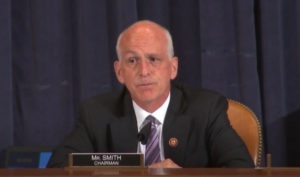Chiding lawmakers’ focus on incremental increases to the defense spending topline, the chairman of the House Armed Services Committee on Friday criticized the ‘painful’ F-35 program and said the Air Force should look to find a cost-effective mix of fighter attack aircraft.
“The failure we wind up tolerating is failure on a massive frickin’ scale, think F-35,” Rep. Adam Smith (D-Wash.) said during a Brookings Institution discussion. “For what we have spent, in terms of what we’ve gotten back, it’s just painful. It just hurts. The problem is there’s not an easy way out of it.”

Smith said Congress should look to “cut its losses” on the F-35, with a focus on working with the Air Force to determine the right mix of platforms so the service doesn’t put all of its “eggs in one basket” for next-generation fighter aircraft.
“I want to stop throwing money down that particularly rathole. We can’t get rid of the program, for those Lockheed [Martin] fans listening. I do understand that,” Smith said. “A big part of that is finding something that makes us not have to rely on the F-35 for the next 35 years.”
The Air Force has indicated plans to find a cost-effective path forward for its fighter attack aircraft to bring down cost per flying hour and sustainment costs, with Chief of Staff Gen. Charles Q. Brown having suggested that an F-16 replacement could be a clean sheet design (Defense Daily, Feb. 17).
The F-35 program, which is the Pentagon’s most expensive platform, has faced scrutiny for its high operational and maintenance costs and delayed progress, with Smith expected to oversee critical discussions on the way forward during this year’s National Defense Authorization Act process.
Air Force Gen. Mark Kelly, the head of Air Combat Command (ACC), said recently he is not confident that the F-35 will reach the $25,000 cost-per-flying hour goal by 2025 (Defense Daily, Feb. 26).
Smith also expressed frustration with lawmakers focusing the defense spending discussion on a push for three to five percent budget growth, which he called “substantively, the least important question we could talk about,” adding HASC must focus on how the money is actually spent.
“Can we all just sort of get off of this epic fight over whether or not it’s three percent or five percent of one percent or it’s cut, whatever, and let’s just spend the goddamn money effectively,” Smith said.
Rep. Mike Rogers (R-Ala.), the HASC ranking member, and several other Republicans on the panel have pushed for the incremental spending growth to meet modernization initiatives, while the prevailing consensus is pointing to likely flat budgets in the coming years.
Progressive lawmakers, meanwhile, have urged Congress to reduce defense spending by 10 percent and redirect the funds towards different priorities, which Smith said he doesn’t support but called a “a substantive policy debate.”